This post is about the game Star Trek Attack Wing (STAW.) You can read more about it here.
I’ve played STAW for months. It’s a great game if you are a Star Trek fan. It’s a great game if you like tabletop miniatures. It has both.
It also has tournaments, called Organized Play, or OPs. Each has a special set of rules. Understanding the rules and understanding the capacity of the various ships can give you an advantage. I enjoy looking at those rules and figuring out how to take advantage of them.
But, not this time. This time I decided that I would go for the more fun experience. I did it by designing a fleet without any captains or crew. It’s kind of hard to do. Star Trek is all about the people. I decided to go with a ship called the Cardassian ATR-4107. In the show it was kind of a drone ship. I decided to go with the named ship, The Dreadnaught, and a generic version. I paired those with two fighter squadrons.
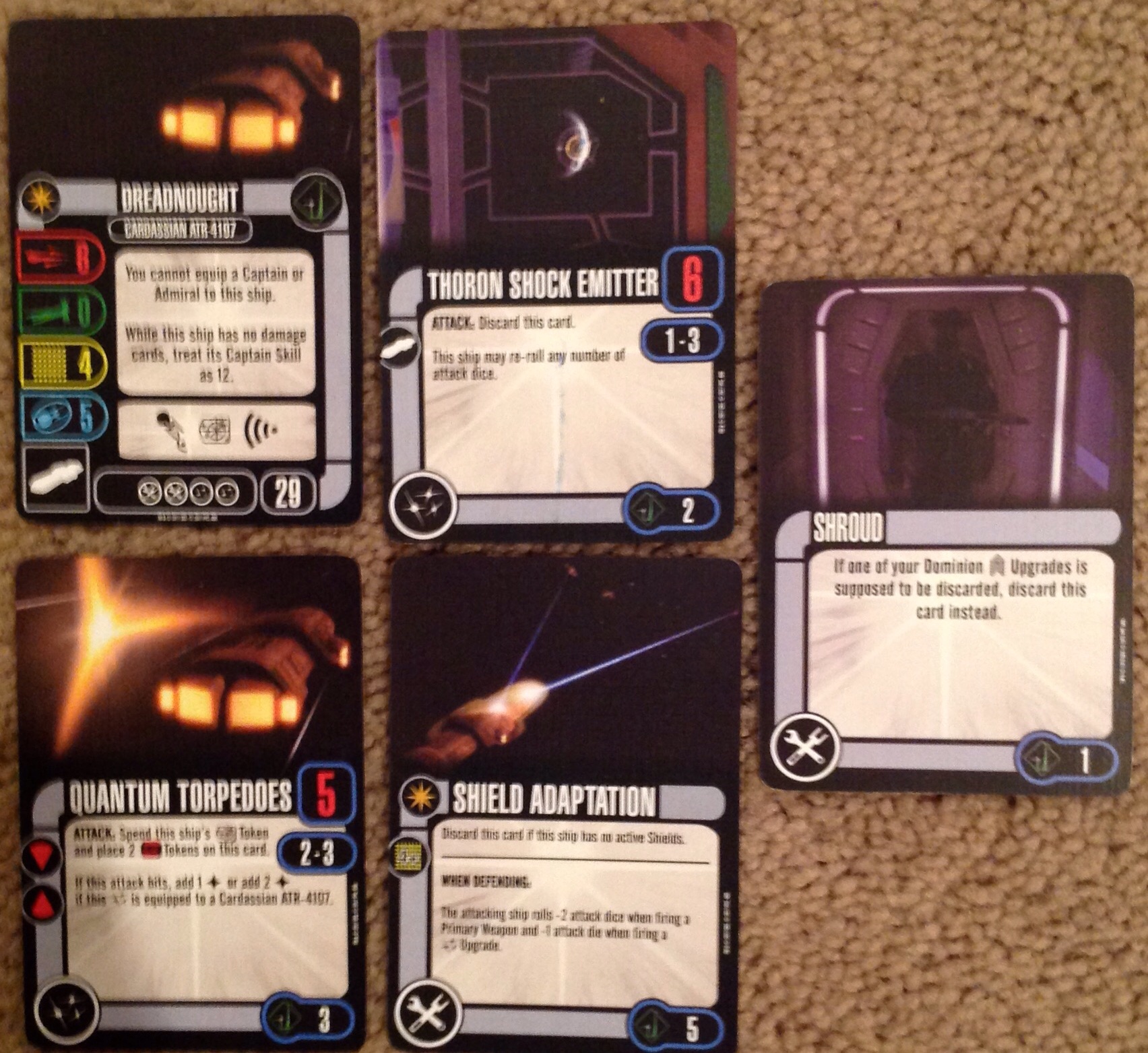
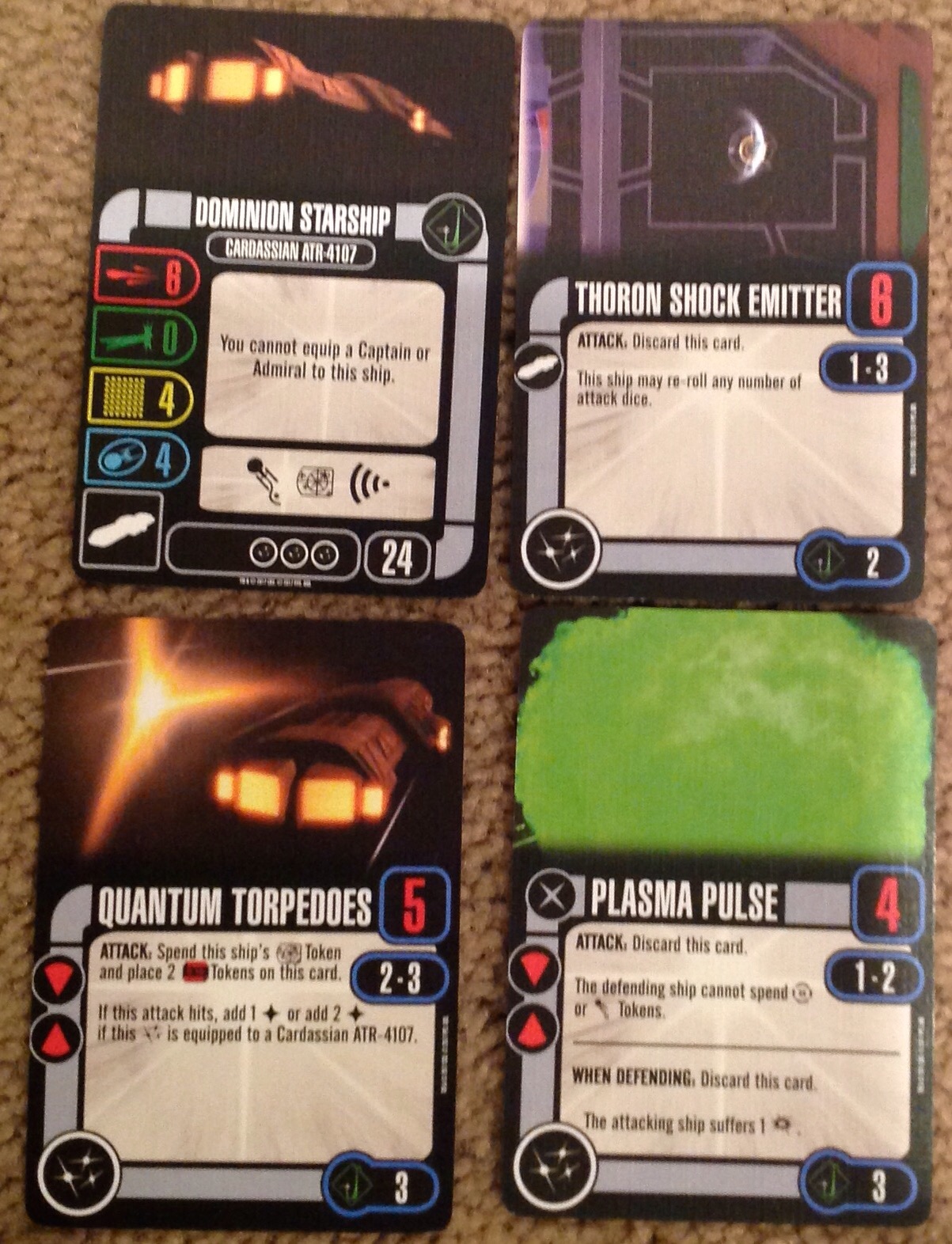
My fleet was definitely not optimized. My friendly local game store (FLGS) has a rule that all the ships in your fleet have to be from the same Star Trek faction. That’s called “Faction Pure.” Actually, we play “Penalty Pure.” That means you can use any card that would not trigger a cross faction penalty.
My ships didn’t violate the Faction Pure rule. But, it had another problem. And the problem is Card Packs. WizKids is the company behind STAW. They recently did a refresh of the game. As part of it, they introduced something called Card Packs. No model, just the cards for a ship and the base template. Combined with my existing ship, I now had two ship bases, but only a single model, single movement card and a single movement dial.

And that was the problem. Not just the problem with my fleet, the problem with Card Packs. I owned two ships. In fact, because the new Dreadnaught from the reboot is cheaper than the old one, I actually bought two card packs. So, now I own three copies of the ATR-4107.
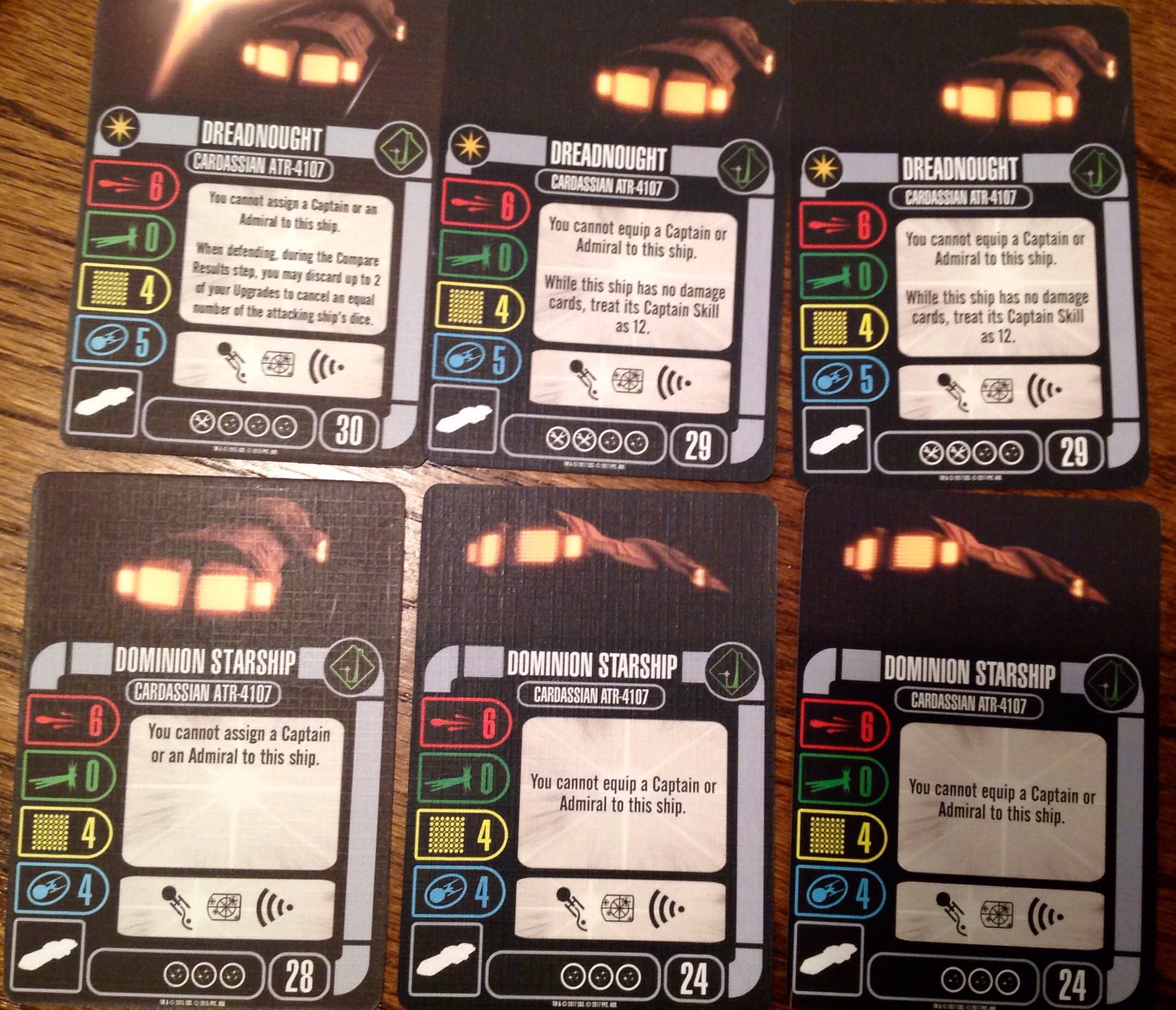
I still only had one movement dial and one movement card. The rules of STAW require a player to have a valid base template (I had three) and a valid ship card (I had six, but could only use four because of rules about unique ship names) and the stickler, a valid movement dial. I had one.
Fortunately, my Tournament Organizer (TO) agreed that since the ATR 4107 and the Galore class used the same movement card, I could use a Galore movement dial. He didn’t have to. He could have excluded my second ship for violating the rules.

That’s the problem with Card Packs. I bought the same ship three times (twice using card packs) and I could only legally play one version of it. I actually ordered another copy of the old version of ATR 4107 just to have another movement dial. Unfortunately, it didn’t arrive in time for the OP.
Despite the issues with the dials, we had a great time. In one final ironic twist, we decided to honor Jon Paul Steuer, an actor who played a Klingon named Alexander on Star Trek The Next Generation. Steuer passed away recently.
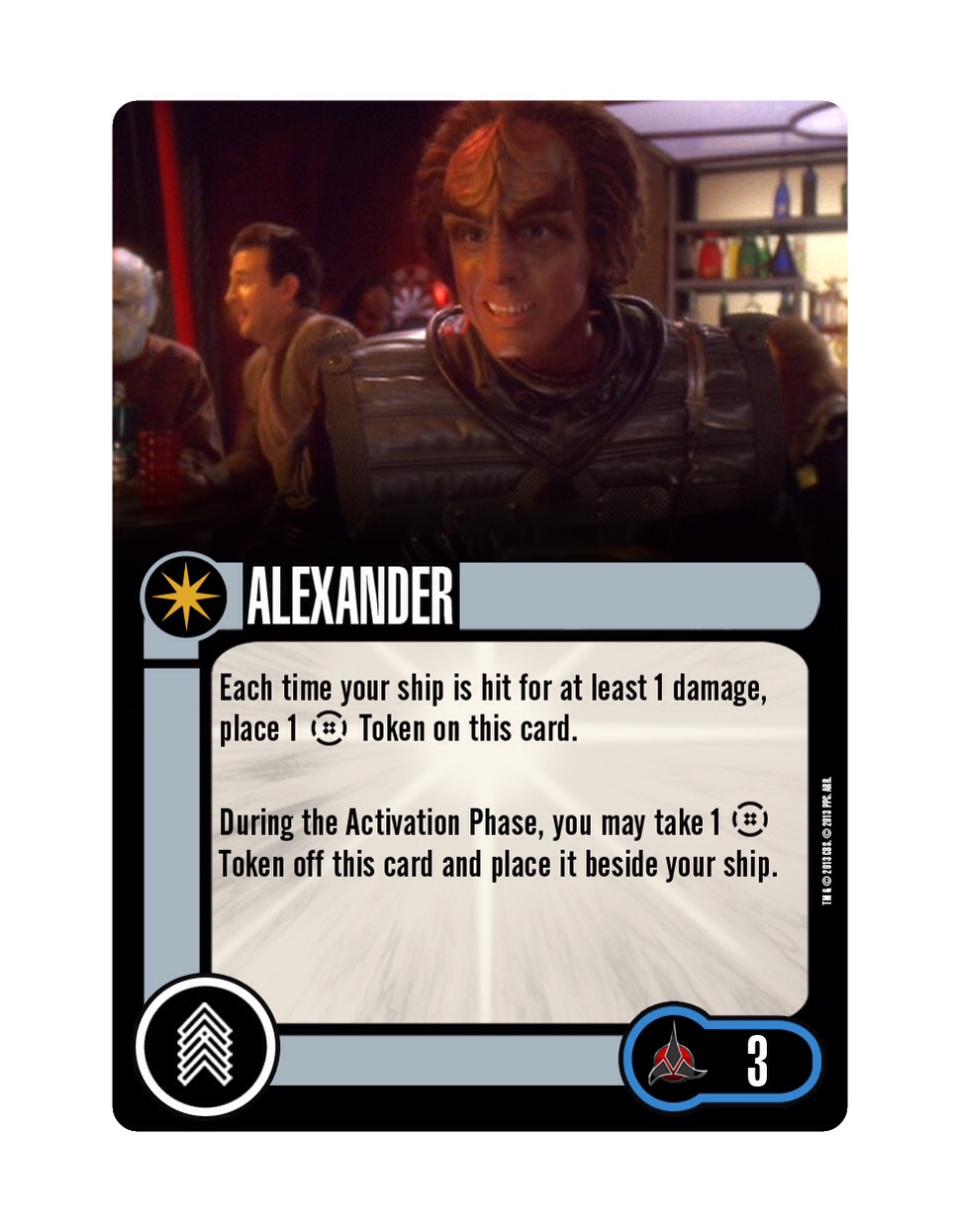
What made it ironic, is that I brought my versions of the Alexander card but couldn’t use it. Despite the agreement that we would waive the cost and the penalty for Alexander, mine was the only fleet who couldn’t use him. I built a fleet that didn’t have room for any captain or crew.
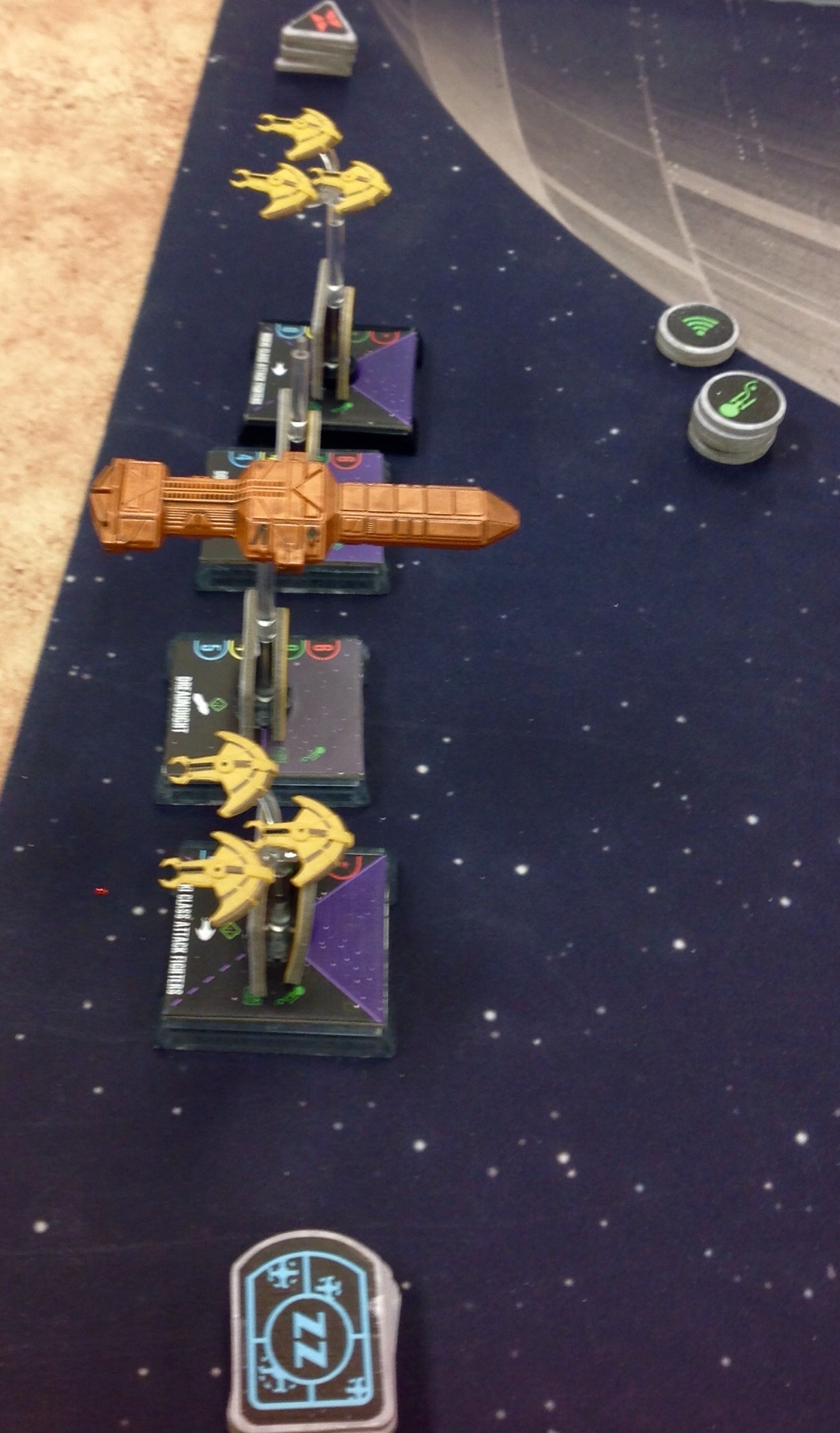
The Headless Horsemen.
Dreadnought [Dreadnought (card pack)] (29)
Shield Adaptation [Dreadnought (card pack)] (5)
Shroud [4th Division Battleship] (1)
Thoron Shock Emitter [Dreadnought (card pack)] (2)
Quantum Torpedoes [Dreadnought (card pack)] (3)
Total (40)
Cardassian ATR-4107 [Dreadnought (card pack)] (24)
Thoron Shock Emitter [Dreadnought (card pack)] (2)
Quantum Torpedoes [Dreadnought (card pack)] (3)
Plasma Pulse [Dreadnought (card pack)] (3)
Total (32)
1st Wave Attack Fighters [1st Wave Attack Fighters] (24)
Galor Class Phaser Banks [1st Wave Attack Fighters] (7)
Total (31)
Hideki Class Attack Squadron [1st Wave Attack Fighters] (20)
Galor Class Phaser Banks [1st Wave Attack Fighters] (7)
Total (27)
Fleet total: 130
Generated by Space Dock for iOS
http://spacedockapp.org
Rodney M Bliss is an author, columnist and IT Consultant. His blog updates every weekday. He lives in Pleasant Grove, UT with his lovely wife, thirteen children and grandchildren.
Follow him on
Twitter (@rodneymbliss)
Facebook (www.facebook.com/rbliss)
LinkedIn (www.LinkedIn.com/in/rbliss)
or email him at rbliss at msn dot com(c) 2017 Rodney M Bliss, all rights reserved

The four foot wide picture was striking. Black paint on white canvas. The brush strokes were bold and vibrant. A black horse in full stride. The legs a blur and even the head and mane were indistinct. The brush strokes evoking the feel of speed and power, an animal at one with the wind.
It hangs in our office in Louisville, Kentucky, the home of Churchill Downs. The famous racetrack where the Kentucky Derby is run every May. Our office is stocked with images of Kentucky thoroughbreds. But, the simple black on white painting is easily the most striking.
Yeah, Michael painted that.
Seriously?
Yeah.
Michael is not the person I would have guessed was an artist. And certainly not one to paint something as bold as the painting I was looking at. Michael and I are friends. He’s already a study in contrasts. He’s a former Marine who has a side job teaching self defense. In person, he very unassuming.
He’s moved to another location, but I wanted to hear the story of the horse painting. It came out over a couple of phone calls and chat messages.
Hey Michael, I saw your painting.
Oh, the horse?
Yeah, that’s amazing.
Thanks. It was actually something I kind of threw together.
What do you mean?
Well, the company president was supposed to be in next day and we wanted a painting, so I just had to sketch something super quick.
So, you did that in one night?
Oh, shorter than that. I sketched it on a piece of paper in and then projected up on the canvas. Probably about 15 minutes.
I trust my friend. But, I found his admission hard to believe.
It’s Rustoleum.
What?
The painting. It done with Rustoleum paint.
Like the spray paint?
No. It was the only paint we had on site. It’s the liquid kind that we use to touch up handrails and stuff. In fact, the next day it was still super wet. I told people to not stand too close it was still giving off fumes.
That’s amazing.
You’re on site, right? In Louisville?
Yeah.
So, I heard they moved it by the bathroom?
Well, it’s closer to the bathroom, but actually it sits in a perfect spot outside of the conference room.
That’s nice.
And hey, even if it’s by the bathroom, at least it won’t rust.
Michael laughed the easy laugh that he has. Like I said, a man of contrasts.
Rodney M Bliss is an author, columnist and IT Consultant. His blog updates every weekday. He lives in Pleasant Grove, UT with his lovely wife, thirteen children and grandchildren.
Follow him on
Twitter (@rodneymbliss)
Facebook (www.facebook.com/rbliss)
LinkedIn (www.LinkedIn.com/in/rbliss)
or email him at rbliss at msn dot com(c) 2017 Rodney M Bliss, all rights reserved
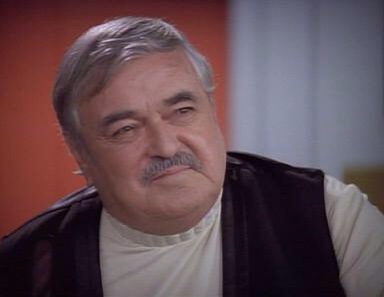
Despite the clever title, the truth is, I forgot. I made notes for yesterday’s entry (This Is Why Your Project Manager Lies To You.) And then, I completely ignored my notes. Mr. Scott, Captain Kirk’s chief engineer on the USS Enterprise was in my notes.
Because, it would have been a much better post if I’d remembered the right hook. Mr Scott, the chief engineer for the USS Enterprise from Star Trek: The Original Series was giving advice to Geordi La Forge, the chief engineer of the USS Enterprise from Star Trek: The Next Generation.
Scotty: Do you mind a little advice? Starfleet captains are like children. They want everything right now and they want it their way. But the secret is to give them only what they need, not what they want.
La Forge: Yeah, well, I told the Captain I’d have this analysis done in an hour.
Scotty: How long will it really take?
La Forge: An hour!
Scotty: Oh, you didn’t tell him how long it would really take did you?
La Forge: Of course I did!
Scotty: Oh, laddie. You’ve got a lot to learn if you want people to think of you as a miracle worker.
Couldn’t have said it better myself. . .and I tried.
What their exchange here.
Rodney M Bliss is an author, columnist and IT Consultant. His blog updates every weekday. He lives in Pleasant Grove, UT with his lovely wife, thirteen children and grandchildren.
Follow him on
Twitter (@rodneymbliss)
Facebook (www.facebook.com/rbliss)
LinkedIn (www.LinkedIn.com/in/rbliss)
or email him at rbliss at msn dot com(c) 2017 Rodney M Bliss, all rights reserved
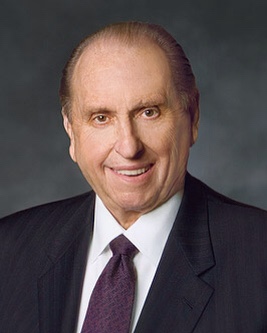
Thomas S Monson died yesterday. If you are not a member of the LDS Church (the Mormons) or you don’t live in Utah, you probably don’t know who he was. Or maybe you’ve heard the name. Or maybe, you know exactly who he was. In any case, I’m going to spend a few minutes talking about him.
He was the president of the Church of Jesus Christ of Latter Day Saints. But, to Mormons, he was more than that. We (because I just can’t write this in the third person “they”,) we believe him to be a prophet of God. Yes, a prophet like Moses, or Noah, or Abraham, or any of those guys in the Old (and some in the New) Testement.
He was 90 years old. He’s been the president of the church for about ten years. Before that, he was a member of the Quorum of the 12 Apostles. Yes, those crazy Mormons believe in both modern day prophets and apostles.
He’s been involved in running the church since he was in his early thirties. Most Mormon leaders at the local level are volunteers. If you attend services at a Mormon chapel on Sunday everyone from the person leading the music, to the people speaking at the pulpit, to the surprisingly young men preparing the sacrament are unpaid. They all have regular jobs that they work at in addition to serving in the church. (Well, except those young men are probably in school.) Those missionaries you see out on their bicycles in the white shirts and ties are also volunteers.
People at the higher levels of the LDS church get a stipend. They are expected to leave their chosen professions and serve the church exclusively. In turn the church gives them money enough to live on. But, many of them simply retire from business and service in the church is how they spend their retirement.
Apostles and prophets are called to the position. No one, even at the local levels, truly volunteers. It’s not until they are asked that people have the opportunity to accept a “calling” in the church.
President Monson, as he’s known to millions of Mormons worldwide, was a man that affected me deeply. In addition to drawing spiritual inspiration from his life and example, he was a scouter. He’s been on the National Board for the Boy Scouts of America for over 50 years. I believe he was the longest serving board member in history.
Scouting is a huge part of my life. It was one of the first activities I enjoyed as a new member of the LDS Church back in 1976. I went on to serve a lifetime in scouting and have been proud to see my five sons follow in my footsteps. President Monson was the scouting program in the church.
Over the past couple of years the boy scouts and the LDS church have drifted further apart. President Monson’s passing will likely accelerate that split.
President Monson was the 16th president of the LDS Church since Joseph Smith founded the church in 1830. The mantel of leadership will pass to another person. Most likely a man named Russell M Nelson. He’s the senior apostle and while it’s not spelled out in doctrine the church policy has been that the senior apostle becomes the president upon the death of his predecessor.
You might extend an offer of condolances to your Mormon friends today. We loved President Monson and will miss him.
Rodney M Bliss is an author, columnist and IT Consultant. His blog updates every weekday. He lives in Pleasant Grove, UT with his lovely wife, thirteen children and grandchildren.
Follow him on
Twitter (@rodneymbliss)
Facebook (www.facebook.com/rbliss)
LinkedIn (www.LinkedIn.com/in/rbliss)
or email him at rbliss at msn dot com(c) 2017 Rodney M Bliss, all rights reserved

If you’d bought bitcoin just three months ago, you would have tripled your money by now!
You’ve heard that, right? Your friends have excitedly cornered you at a holiday party and explained how rich you could all be if you’d cash out your 401K and pour the money into Bitcoin.
Don’t do it.
Wait, I have to add this next part: I am not a licensed financial planner and nothing in this post should be construed as legal or financial advice. For entertainment purposes only. Your mileage may vary. Remember to spay and neuter your pets.
With that out of the way, you’re not going to get rich betting on Bitcoin. And “bet” is a good word for it.
If I’d just picked numbers 28 36 41 51 58 and the Powerball of 24, last week, I’d have won $350,000,000!
Sure, and. . .
If I’d just bet on 23 Black on the roulette table last month in Vegas, I’d have won 30x my bet!
In hindsight, every bet could be a winner. In hindsight, I’d have bet on the presidential election! Financial planners have a saying,
Past performance is no indication of future results.
So, Bitcoin is a worthless scam, right?
Not exactly. There is no doubt that people have made a lot of money with Bitcoin. But, if you are a little shaky on what exactly Bitcoin is, you should probably not bet your house on it.
First, let’s talk a little about what Bitcoin is. Bitcoin is a cyber currency. There’s no actual “coin.” There was recently a story about a guy who sold a million dollars worth of Chuck E. Cheese tokens as “Bitcoins.” If you think about it, your debit card is a type of cashless currency. You don’t have to have the physical paper money to make a purchase. If the buyer and seller both agree to do an exchange in that currency, you can transfer the money with just a swipe of your card, or typing your card number into a web page.
So, if there’s no actual physical currency, how do you use Bitcoin? Unfortunately, you cannot use it like you use your debit card. There are places you can go buy Bitcoins. They are called exchanges. You give them money and they will sell you some bitcoins. Or, more accurately, they will sell you a portion of a bitcoin, since each “coin” is about $14,000 at current prices.
You can also invest in Bitcoin futures. That’s where you bet on what the future value of Bitcoins will be. Bitcoins and Bitcoin futures are like any scarce or limited resource. If there is a limited supply and more people want it, the price will go up. That’s currently what’s happening with Bitcoin. As more people want to buy it, the price keeps climbing.
There’s another way to get Bitcoins and this is what makes them a somewhat unique cyber currency. You can “mine” Bitcoins. The analogy of mining for gold is actually pretty accurate. But, since Bitcoins don’t live outside of a computer, it makes sense that you need to use a computer to do the mining. Bitcoins are defined by a complex set of numbers and algorithms. You can use your computer to try to run the algorithms and derive the numbers.
But, there’s also a limited number of Bitcoins that can be mined. And, not to shatter any business plans, but the Bitcoins that were easy to mine are all gone. It now takes a lot of computing power to find new Bitcoins. You are not going to let your PC run overnight and wake up to a virtual pot of gold Bitcoins.
Finally, let’s talk about how you spend Bitcoins. The money that is currently being made is in the markets. As people buy and sell the coins and the futures. If you bought a Bitcoin at $5,000 and you sold it at $10,000, it’s pretty easy to see you made money. But, Bitcoins also have a use. They can be used to buy and sell things.
This is the dark underbelly of the Bitcoin story. Bitcoins are untraceable. So, they are very attractive to people who want to buy and sell things without anyone being able to tie their purchase back to the buyer.
There’s a portion of the internet called the Dark Web. It’s the seedy back alleys of cyberspace. It’s the “bad” part of town. On the Dark Web you can buy and sell virtually anything: weapons, drugs, child porn, contract killings, people. It represents the very worst of our society.
By investing in Bitcoin, you are not necessarily supporting the illegal activities that can be purchased with it, of course. Just be aware that currently, the people using Bitcoin for commerce are not buying baby formula and bake sale cookies.
Should you invest in Bitcoins? Sure. as part of a broader, balanced portfolio. There is speculation it could go as high as $60,000 per coin this year. That’s about four times what it is right now. But, there’s also the chance that it will get supplanted by the next big cyber currency and the bottom will fall out. Unlike other investments, there is currently no agency that oversees the trading of Bitcoins. There’s no SEC, FDIC or any other three letter acronym that is interested in making sure that Bitcoin trading follows expected rules of investments.
It is very much: Buyer beware.
Rodney M Bliss is an author, columnist and IT Consultant. His blog updates every weekday. He lives in Pleasant Grove, UT with his lovely wife, thirteen children and grandchildren.
Follow him on
Twitter (@rodneymbliss)
Facebook (www.facebook.com/rbliss)
LinkedIn (www.LinkedIn.com/in/rbliss)
or email him at rbliss at msn dot com(c) 2017 Rodney M Bliss, all rights reserved
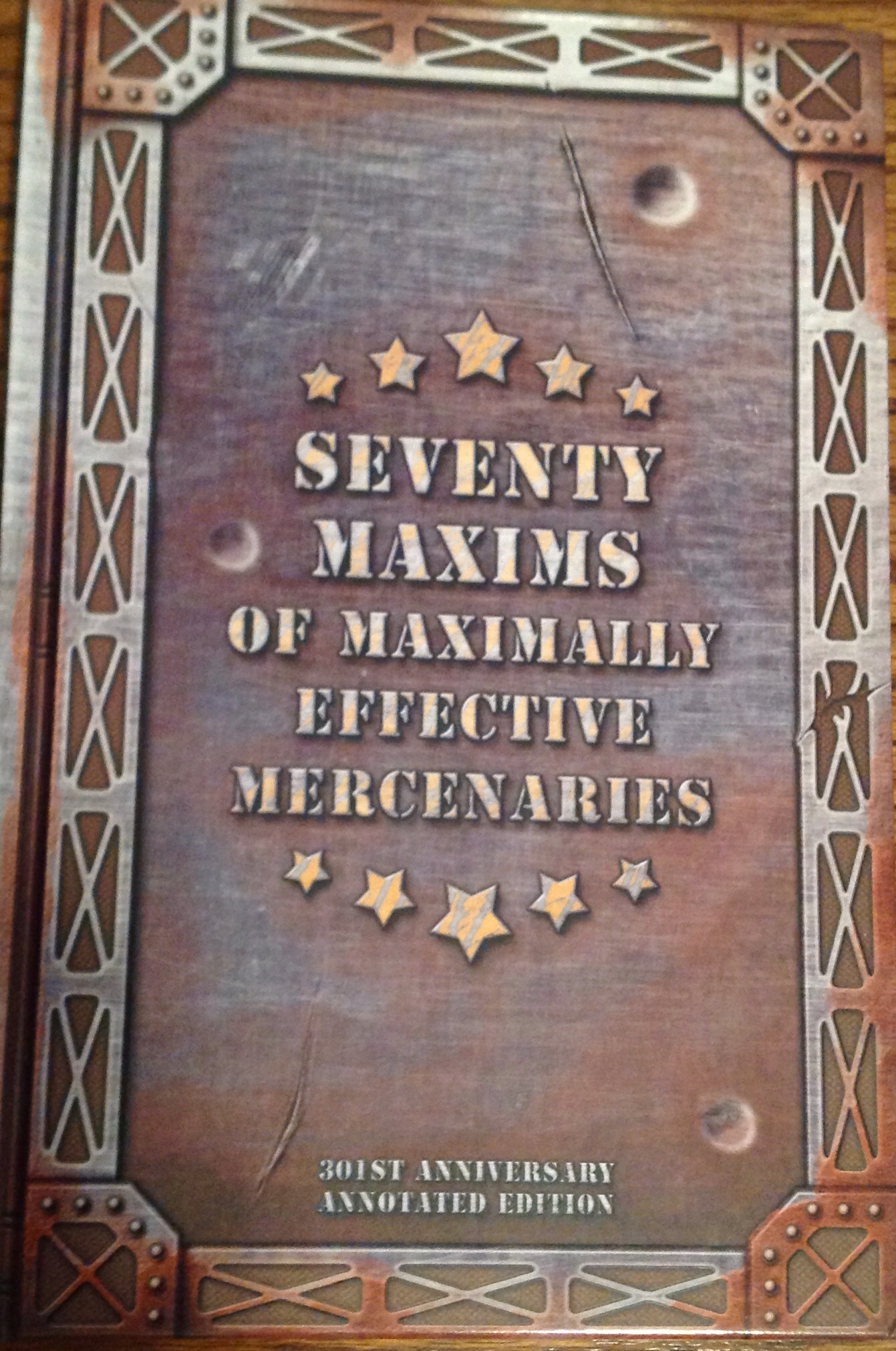
Straight out of the box, the book looked like it had been shot. . .and stabbed. The pages were yellow with water staines, coffee cup “rings” and the literal scribbling of multiple people in black, red and blue ink. And even some werid green felt tip marker. Had I loaned a book to a friend and it came back in this condition, I would have one less friend. And yet, it was perfect! Exactly what I hoped it would be.
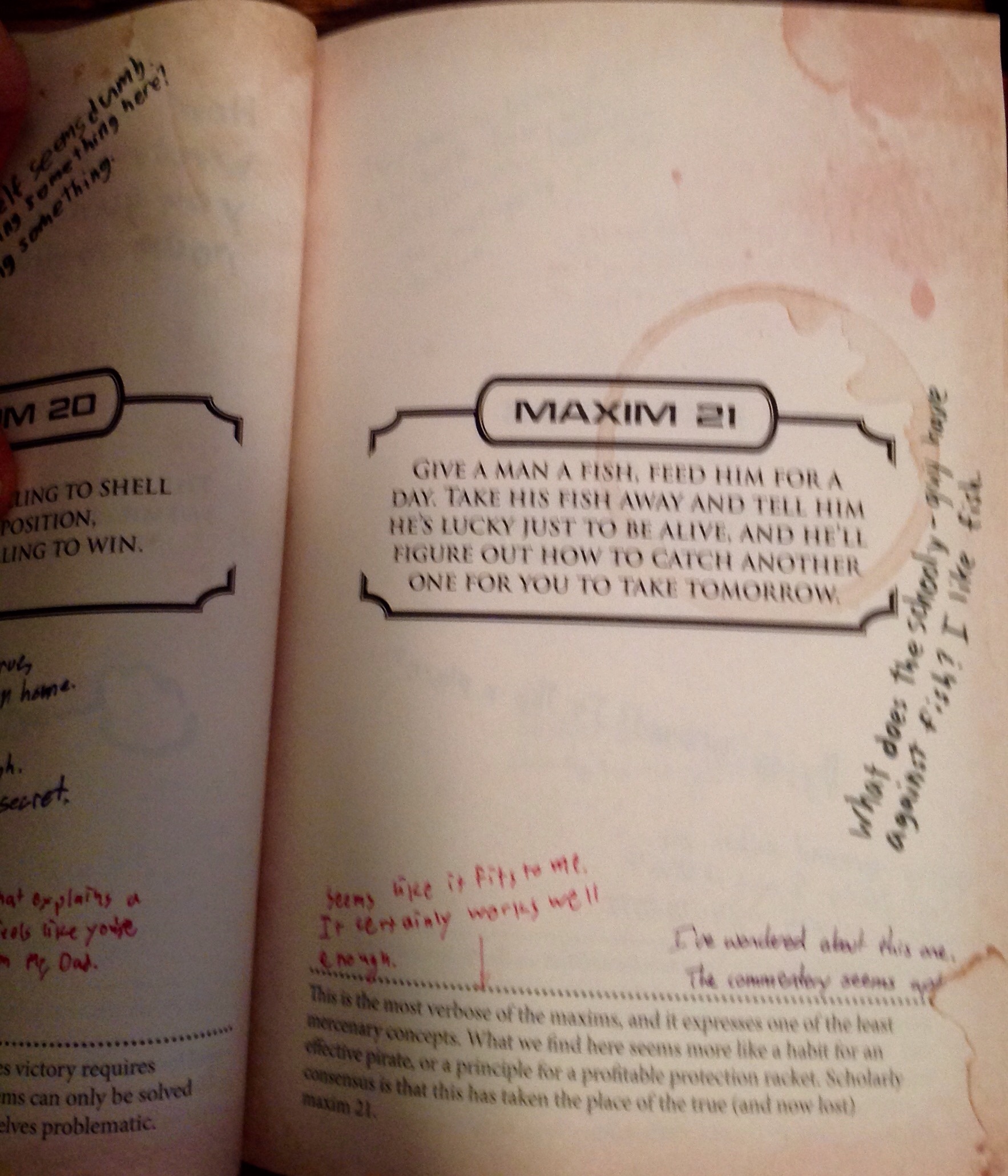
Last year I reviewed Seventy Maxims of Maximally Effective Mercenaries. It’s a book of maxims based on the award winning online comic Schlock Mercenary. Much like the book Princess Bride, which is credit to “S. Morgenstern” but is actually written by the talented William Goldman, Seventy Maxims is credited to the fictitious author Link Weimar. If there is any doubt he is fictitious, the fact that the Introduction page is dated “June 12, 2700” should be a major clue. It’s also a subtle Easter egg for fans. The first Schlock Mercenary strip appeared June 12, 2000.
The book was actually the creation of Howard Tayler, the brilliantly funny creater of the aformentioned Schlock Mercenary. When Howard decided to create a real-world version of his in-universe mercenary instruction book, he promised his readers a version “annotated by Karl Tagon,” one of the principal characters in the strip.
When it came time to actually create and produce the book, Howard realized he had a problem. While he was certainly capable of creating a book and then adding annotations from not just Karl, but his son Kaff, a Sgt Edwards, another captain named Murtaugh and the titular character Schlock himself, anyone not intimately familiar with the source material would be completely confused by seemingly random scribblings throughout the book.
Howard’s solution was to produce two versions of the book. The first, the pristine version, works great as a gift to friends who are not (yet) fans of the online comic. The pristine version of the book reads like a somewhat tongue-in-cheek version of many self-help books.
For the fans, and in order to keep his promise of an annoted version, Howard created the defaced version. The level of detail is amazing. Just looking at the pages, it is impossible to tell they are not actually stained and damaged. Like all items from Hypernode Press, the production value is outstanding. It’s only when you touch the pages that you can tell they are not damaged.
The writing is equally brilliant. To provide variety, Howard enlisted several co-writers to provide differing handwriting styles. He also assigned a consistent color to each author. This helps decipher the notes later on since the characters are only identified in the flyleaf.
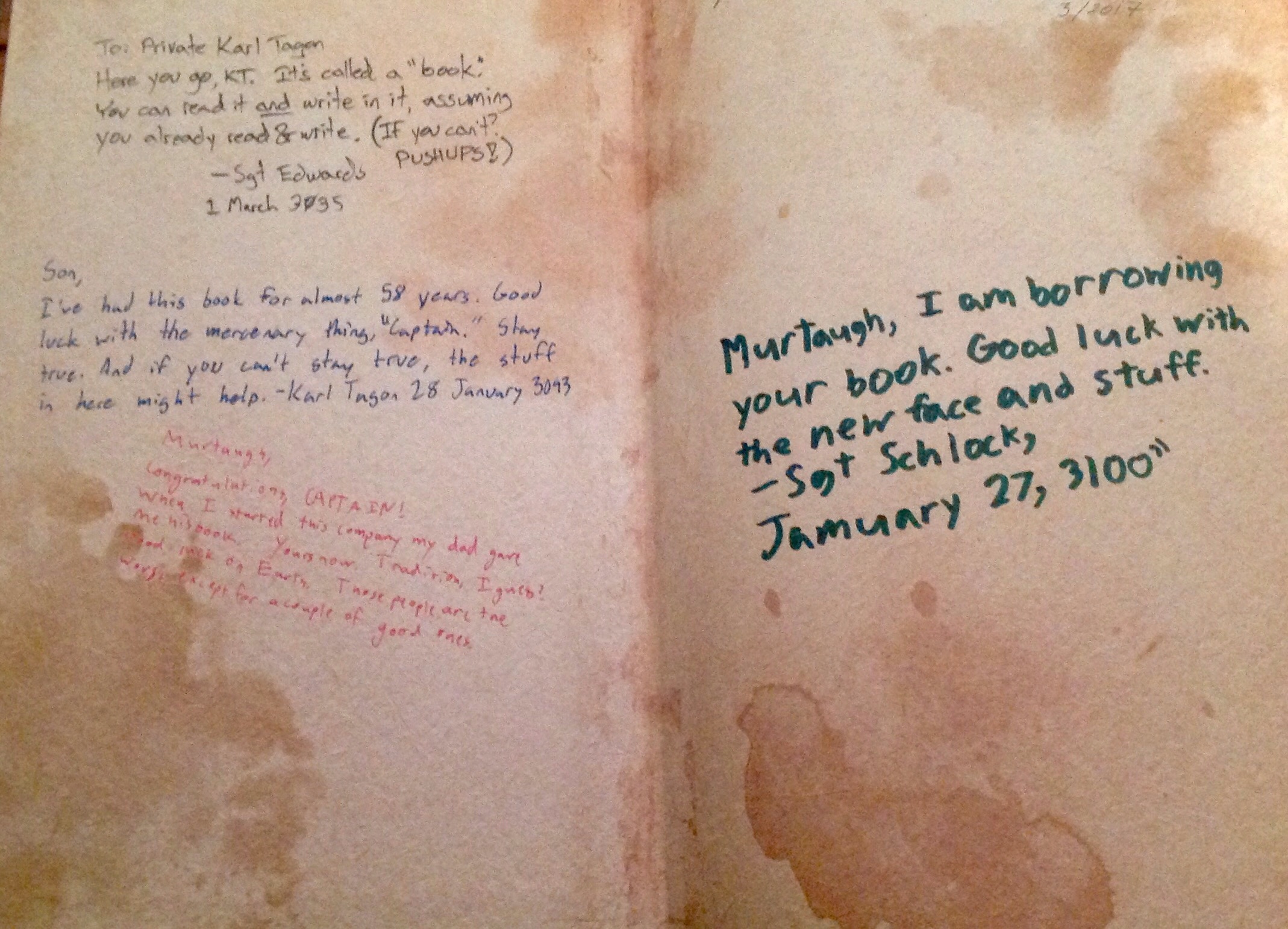
What I Liked
As a fan of the comic and the maxims, it was wonderful to finally have the maxims in book form. It was also great fun to see how each character felt about each of them. The five characters that Howard chose represent a good cross section of his universe and are able to offer completely different perspectives on the various maxims.
I’ve already mentioned that the production value was outstanding. The “art work,” and I don’t know what else to call unique colorization for each page, is very believable, without detracting from the readability.
What I Didn’t
While Howard used unique colors to keep the characters comments separate, it was nonetheless still confusing at times telling the voices apart. Except Schlock in his big green felt pen. I’m not sure I have a better suggestion, but it was still confusing at times. Sgt Edwards is identified as the original owner of the book. Because he doesn’t figure into the online comic story, except as part of a flashback that I may have missed, his comments were less impactful than the characters we were more familiar with.
Reading the book, especially for the first time, is a challenge. Each page has the stated maxim, the printed scholarly commentary, and the “handwritten” commentary from the characters. Reading each page in its entirety breaks up the flow of the character conversations. But, skipping some of the content to follow the characters’ conversation also feels incomplete. Ultimately, I think it was this challenge that influenced Howard to create a pristine copy. I found the “best” way to read the book was:
- Read just the maxims starting with #1 through #71
- Start over and read the scholarly commentary on each page
- Start over and read the character comments on each page
- Start over and add your own comments to each page
Fortunately, it’s a relatively short book. By the time you’ve been through it multiple times, it’s easier to keep the character voices distinct. And rereading doesn’t detract from the enjoyment at all.
What It Means To You
If you are a Schlock Mercenary fan, you should absolutely get this book. It will provide you with hours of entertainment and help you feel like you know the characters and the Schlock-universe even better. If you have never heard of Schlock Mercenary, this book will be confusing. I would instead recommend the prisine version.
My Rating
For Schlock fans: 4 out of 4 stars
For Non-Schlock fans: 2 out of 4 stars
Rodney M Bliss is an author, columnist and IT Consultant. His blog updates every weekday. He lives in Pleasant Grove, UT with his lovely wife, thirteen children and grandchildren.
Follow him on
Twitter (@rodneymbliss)
Facebook (www.facebook.com/rbliss)
LinkedIn (www.LinkedIn.com/in/rbliss)
or email him at rbliss at msn dot com(c) 2017 Rodney M Bliss, all rights reserved
This surprised me.
As a writer, I typically have at least some idea of what will be popular. I write five days a week, about 800 words per day. That’s 4,000 words per week, or about 200,000 words per year. For comparison, Harry Potter and the Philosopher’s Stone was about 77,000 words.
And yet, occasionally I get completely blindsided. This was one of those posts. It’s a pretty simple story. I had a bad experience at a local Pleasant Grove store. I wrote about it and how I had decided to no longer shop at that store and no longer buy a brand of tools that they sell.
Honestly, that is how brands and companies lose customers.
But, what I didn’t anticipate was the level of defensiveness it would spark by the members of my little town where the store is located. It didn’t matter that in the firestorm that erupted online in the comments section, I assured everyone that I wasn’t trying to get anyone else to boycott the store. It’s a wonderful store. And since my town is small, I really, really want people to support local businesses. In other words I didn’t want people to base their shopping decisions on my experience.
What was surprising was the number of people who insisted that I should base my shopping decisions on their experience.
I had a great experience at this store. You should keep shopping there.
My neighbors were very sincere in their insistance that I was maligning a multi-generational institution. No amount of protesting on my part that my motives were different would appease them.
My daughter suggested that my protesting was disingenous. She pointed out that as a blogger, and a journalist, it is impossible for me to offer an opinion without also advocating for my own position. Like the guy who at the top of his voice screams,
BUT, I’M NOT YELLING!!
Lost in the entire discussion was my actual point: that it’s easy to lose customers, even customers who have been loyal to your brand or store for generations.
——————-
THIS IS HOW YOU LOSE A 3RD GENERATION CUSTOMER
November 21, 2017
I broke a tradition today. It was a tradition that my grandfather started. He passed it on to my father. My father passed it on to me and I passed it on to my children. But, no more. It happened at 3:30pm at Allred’s Ace Hardware in Pleasant Grove, UT.

I normally don’t use this platform to call people or businesses out. I’m making an exception. And while my story is about a family owned hardware store in Northern Utah, the lessons apply to any business that is interested in keeping its customers.
It all happened because of a broken 6-point 13mm Craftsman brand socket.

All of those details except the size are important to the story. I’ve never broken a socket before. And certainly not a Craftsman brand socket, my brand of choice. Craftsman brand tools are not the best tools you can buy. I would say Snap-On or Matco tools are probably the top of the line. But, I like Craftsman because they are good quality and if you happen to break one, they replace it, no questions asked.
My grandfather was a junk dealer. When he passed away, I inherited his tools. There were a lot of Craftsman brand tools in his tool chests. There were a lot of old and well used Craftsman brand tools. At one point I took one to Sears (the exclusive Craftsman dealer at the time) and traded it in. It was about 60 years old. They handed me a brand new one and I walked out. They didn’t even ring it up. Just a one-for-one trade.
I loved Craftsman tools.
Anyway, I broke a socket. I was changing the brake pads and I was taking off those super tight bolts that hold the brake pad housing on. The wheels were off my car and I needed to fix the brakes before I could go replace the socket. Saying you need a new socket is like saying you need a truck. There are actually lots of different 13mm sockets. First is the idea of the number of points: six or twelve.

I prefer six point sockets. They are typically stronger. My current situation notwithstanding. And they don’t risk stripping the nut as much as a twelve point socket. The advantage of a twelve point socket is that in situations where access is tight it helps to be able to adjust the socket slightly.
Next is the idea of a short or deep socket.

Sometimes a bolt might be longer and the socket has to fit over it to remove a nut. Or, it’s just easier to reach with a longer socket. After a broke my short 6-point, I switched to a deep socket. Mostly, because I knew that I couldn’t break this one.

The final aspect of a socket is the size of the drive. Typical sizes are 1/4?, 3/8? or 1/2?. You can get into bigger sizes as well, but for most mechanic work, a socket is going to be one of those three. I had other 13mm sockets, but they were 1/4? drive. I would have snapped the socket driver. The one I went with was deep, heavy and a 1/2? drive. I would break the bolt before I broke the socket.

I have a lot of tools. Between what came to me from my father and grandfather, and the tools I’ve purchased over the years, I estimate I have about $15,000 worth of tools in my garage. And I buy tools on a regular basis. Generally, I go to a big-box store. They have the selection and their prices are good. But, I also like to support my local family owned hardware store, like Allred’s Ace Hardware.
That brings me to my visit this afternoon. I love to shop for tools. And, I typically know what I’m looking for. I found the socket section and located the Craftsman brand 13mm 3/8? drive short socket. But, it was a twelve point instead of a six. I looked and looked and couldn’t find a six point. I decided that it was mostly personal preference, and a twelve point would work just fine. I also picked up a couple of other tools that I needed. If you have a house full of teenage boys, there is often a hole in the bottom of your tool chest.
As I was picking out my replacement tools, there were a couple of employees helping a woman make a new house key. The machine is automated so I’m not sure why they needed two of them, but I didn’t think much of it. As I started toward the front of the store, a manager joined the key club. I addressed the group,
If I want to exchange a broken Craftsman tool, do I just take it up to the counter?
(I recieved slightly confused looks)
Craftsman still has a lifetime replacement guarantee, right?
Well. . .they do for now. Black and Decker just bought them and they may be changing the guarantee, but as of today, it’s still in force.
So, do I just take them up to front?
(Helpfully, I held up the broken socket and the replacement.)
This is a six point, but you guys only have the twelve point, so I was going to swap them.
Oh, you have to match the numbers.
What?
We can only replace a Craftsman tool that is the exact same number. So, we won’t be able to exchange these.
Do you have any 6-point 13mm short sockets?
If it’s not on the shelf then we don’t carry it.
Do you know anyone else that carries Craftsman tools?
Ah. . .no. Sears stores used to, but most of them are out of business.
And with that she turned her attention back to the key lady.
Well, thank you for your time.
I replaced the Craftsman 13mm 3/8? drive twelve-point short socket. And then I replaced the rest of the tools I had been planning to buy. I walked out of Allred’s with two resolutions:
1 Never to buy another Craftsman tool
2 Never to go back to Allred’s if I can help it
I drove across town to the big box store. Do you know that their hand tools come with a lifetime guarantee? And their selection is huge.

I’m not trying to start a campaign. I’m not trying to start a boycott. I’m telling you what I decided to do based on the customer service that I received. You might think I’m being harsh. The employees were not rude. And they were simply quoting me the company policy. But, they made two fatal mistakes.
First, they refused to stand behind a brand that they have in their store. They expressed uncertainty about the future of Craftsman tools. That was a stupid thing to do. The policy is exactly what it has always been. They didn’t need to speculate that it might change.
The second flaw, even worse than the first (because they have other brands that I might still buy even if I abandon Craftsman) was they didn’t seem to care. they didn’t care about replacing my socket. They didn’t care that there was literally nowhere else for me to go. Well, there was somewhere else to go. And I went. The quality of big box store tools are probably about the same as Craftsman. The prices are cheaper. The value of going to a locally owned store is to support our community. I’m willing to pay a premium for that.
This was a $2.50 socket. I didn’t need to have it replaced for free. But, the experience means that the thousands of dollars of tools I buy will be purchased somewhere else. That’s a pretty expensive lost sale for $2.50.

I had several 13mm sockets, but needed one more.
Rodney M Bliss is an author, columnist and IT Consultant. His blog updates every weekday. He lives in Pleasant Grove, UT with his lovely wife, thirteen children and grandchildren.
Follow him on
Twitter (@rodneymbliss)
Facebook (www.facebook.com/rbliss)
LinkedIn (www.LinkedIn.com/in/rbliss)
or email him at rbliss at msn dot com(c) 2017 Rodney M Bliss, all rights reserved
The second most popular post from last year was again concerning the Star Trek Attack Wing game. I figured out how to win a tournament without any risk. I literally couldn’t lose. But, while I did win, the results were not what I expected. I’ve never felt so terrible after winning a game. . .and I hate to lose. In this case, winning definitely felt like losing
———————–
HOW A ‘CAN’T LOSE’ LOST
April 17, 2017
Three months. For three months, I’d been planning it. And no matter how I looked at it, I couldn’t see a way to lose. No matter what the other guy tried, I was going to win. I replayed the scenario over and over in my mind, looking for any flaw in my strategy. I was going to win. It was going to be great.
I was right and very, very wrong.
I’ve recently started playing a game called Star Trek Attack Wing. The game is fun, especially if you’re a fan of the Star Trek series and movies. The game is simple, and very complex. You pick a ship, or serveral ships. You pick a captain, crew members, weapons and any tech upgrades. Then, you put your fleet against your opponent’s fleet in a 36? x 36? play area. Of course, there are attack dice that cause damage to your opponent, defense dice that help keep you from taking damage, movement options and several Star Trek specific features, like cloaking or “warp drive.”
The scenario we played on Saturday was simple. It was based on the Klingon Civil War, a series of episodes from Star Trek: The Next Generation television series. However, I noticed something about the rules. In a tournament, (also called an OP for Organized Play) the victory conditions involved not only defeating the enemy ships, but also accomplishing specific mission objectives. One of these was to have one of your ships make a particular movement called a “banked sensor echo.” You got 5 victory points each time one of your ships performed this move.
A typical “fleet” included 3 ships, each valued at about 40 points. Given that a typical game goes four or five turns, the victory points for the sensor echo were not nearly as important as trying to kill one of the opponent’s 45 point ships.
Except, there was a flaw in the scoring. Researching strategies from those how had already played the OP, they pointed out that instead of 3 ships costing about 40 points each, you could choose to field 12 ships costing 10 points each. Now, these little ships were not very strong. There was no way they would be able to kill a 40 point ship. But, they didn’t have to. All they had to do was sensor echo each turn and they’d rack up points. After the first turn, you’d earn 60 victory points from sensor echoing. After two turns, you’re at 120, the value of the opponent’s entire fleet. After the third turn, there is literally no way that you could lose. Even if your opponent kills a few of your ships, the remaining ones will continue to score points until the one hour time limit is reached.
It wasn’t a completely painless strategy. Each ship, cost $15 retail. Even finding some on sale, it wasn’t cheap to buy a bunch of these weak ships. But, there were prizes awarded for winning the OP. And technically the rules allowed this setup.
I couldn’t lose.
But, I did. Oh, not the battles. They went exactly as I had practiced. The first game, I lost three of my twelve ships, but I completed 44 sensor echoes.
Game 1 Final Score:
Him: 33 points
Me: 220 points
Not even close. I win! And that’s when I realized the real flaw in my plan. The person I was playing was good player. He enjoyed multiple types of games only one of which was Star Trek. He played a competent game and aside from some very unlucky dice rolls, played well. But, he didn’t have any fun. He knew the result before we started. He only agreed to play because it was a tournament.
The second game was between the other two players at the OP. The one I’d played first had a 4 ship fleet, with a very weak ship acting as his flag ship. The second player had three strong ships. The battle was back and forth for the first 45 minutes, but the tide turned in the last quarter hour and one person came off victorious. It was a hard fought battle and both players had a lot of fun. Even I had fun and I was just watching.
The third game of the night was me against the loser from the second game. He’d seen the first game and had some ideas on strategy. We were pretty quick between turns and managed to get eight turns completed within the hour. He killed three of my ships. I never took even a single shot at his ships.
Game 2 Final Score:
Him: 34 points
Me: 350 points
I had come to the tournament with a specific strategy and it had paid off brilliantly. And I have rarely been so embarrased in my life. I found myself apologizing to my two opponents. The three of us played for three hours, one hour of which was enjoyable and two hours of which were pretty boring and not fun.
Yes, I knew I was going to win. I spent a not insignificant amount of money buying special ships to ensure I won. I came with a plan and it worked beautifully. I won not only the prize ship for the night, but the grand prize for the entire 3-month campaign.
And I went home the biggest loser. The point of the game was not to win the prize ships. The point of the game was to enjoy each others company and to play your fleet against the other guy’s fleet. But, I completely missed the fact that “playing” and “winning” were not the same thing.
To Aaron and Will, I apologize. I’ll try not to lose so badly in the future.
The best game of the night played out on a Star Wars game mat.
My strategy of “Run but don’t fight” was more accurately described as “You can’t win.”
What a typical fleet looks like.
My il-fated winning fleet.
Rodney M Bliss is an author, columnist and IT Consultant. His blog updates every weekday. He lives in Pleasant Grove, UT with his lovely wife, thirteen children and grandchildren.
Follow him on
Twitter (@rodneymbliss)
Facebook (www.facebook.com/rbliss)
LinkedIn (www.LinkedIn.com/in/rbliss)
or email him at rbliss at msn dot com(c) 2017 Rodney M Bliss, all rights reserved
The third most popular post from 2017 was a story of tragedy and triumph. I’m an assistant scoutmaster in Boy Scout Troop 832 in Pleasant Grove, Utah. We are a very active troop. We take the boys out camping 11 months each year. (November is our month off.) Utah can be a pretty inhospitable environment if you are not prepared. This post describes not only some of the tragedies that befell hikers and campers in and around Utah, but explains why we take the risks. Why despite all the safety precautions, we put our children into potentially life threatening situations.
—————————–
LEADING BOYS SCOUTS TO THEIR DEATH
August 9, 2017
Jeffery Julian is dead. He was 17 years old. He didn’t die from drugs, or alcohol. He was in good health, a football player at Salem, UT High School. He wasn’t engaged in any risky behavior. He died simply because he took a hike in the mountains last week. His scout troop hiked up into the High Unitas in Northern Utah. He most likely died of altitude sickness.
Sarah Beadle is also dead. She was 38. She wasn’t a Boy Scout, of course. She was an emergency room doctor. She also went for a hike. She went with her daughter and nephew on a hike in Grand Canyon National Park two weeks ago. She died within 3/4 of a mile of Phantom Ranch in the park. She ran out of water and got lost. the children survived.
Three sisters are in the hospital, a 7 and an 8 year old in Salt Lake City and a two year old in Evanston, WY. They were fishing in the High Unitas. The storm came on them quickly and before they could get to a less exposed area, the lightning hit. All three are expected to recover.
Jhonatan Gonzalez considers himself lucky to be alive. Jhonatan is a 40 year old man from Hawaii who nearly died along with several other hikers in Zion’s National Park in Southern Utah last week. They were hiking in an area of the park called “The Narrows.” It’s a slot canyon with a gentle river in the bottom and sheer sandstone walls on both sides. He, along with several other hikers were caught in a flash flood. They formed a human chain across the waist high water to help each other to safety.
Pay attention to this next part. If you do it wrong you might die.
I joined the Boy Scouts when I was eleven years old. I went on to get my Eagle and stayed involved with the troop until I turned 18. I never once remember a scout leader telling me that the activity we were about to engage in might result in my death. And I went on a lot of campouts.
I’m an Assistant Scoutmaster in our troop. We are a very active troop. We go camping eleven months each year. I use the above phrase with our boys at least 3-4 times per year. The boys hear it a lot, but they also take it seriously. See, in September we will take our boys on a overnight backpacking trip to the High Unitas. In June we took them to Zion’s and hiked The Narrows. We don’t hike the Grand Canyon, but we do plenty of hiking in Utah’s canyons and desert.
My sons are 14 and 17. They no longer go on campouts with me and the “younger” scouts. But, their groups are equally active. And face similar dangers. As I was reading the online comments about Sarah Beadle, the ER doctor who died in Arizona, I saw several people questioning why she would even be out there. It was 100
degrees that day with little shade on the trail she was hiking.
Why do we put ourselves and our boys at risk? While we do everything we can to train our boys and make sure they are prepared for the wilderness, the fact remains that we are taking them into a dangerous situation. Jeffery Julian, the young man who died of altitude sickness, did everything right. He followed all the rules of safe hiking. And while the High Unitas are about 7,000 feet above sea level, his home town of Salem is 4600 feet. And, as an athlete, he was acclimatized to the elevation.
No leader wants to lose a boy. We had a case several years ago where a young man on a winter camp got frostbite and nearly died of hypothermia. We scaled back snow camps for several years. We do everything to reduce the risk, but we cannot lower it to zero. Is any risk too high, if the result might be death?
I’ve watched my five sons go through the scouting program. We do the same campouts at the same time each year. I watch 12 year olds struggle to make it up the trail. I’ve seen my share of tears as boys think the task is greater than they can manage. A year later, I watch those same boys lead the group, pushing us all to keep up with them. It’s not just their bodies that get stronger, it’s the knowledge that they can do hard things. And they know they can, not because we tell them, but because they experience it.
The second reason we take our boys out into the wilderness is to help them understand that life is full of challenges. But, if you are prepared you don’t need to fear. Again, watching my sons, I’m gratified when I see them tackling difficult challenges. They are more confident in school and in their daily lives.
Thirdly, they learn that actions have consequences. We would never intentionally put the boys at risk. But, when we tell them that they need to bring enough water, and they run out, they quickly learn that their choices and their actions have an immediate impact on their lives. With water, because it’s so precious and essential, we, as leaders, always bring extra. But, the boys have to come and ask for it. They learn the value of planning ahead.
Every month, I consider the difference in my own camping experiences growing up in Western Washington and the experience that our scouts have camping in the desert. It makes me extra careful to ensure I’m teaching them the skills they need to survive. And I remind myself that I need to pay attention. If I do this part wrong we might die.
Below are links to the stories about people I mentioned above.
Rodney M Bliss is an author, columnist and IT Consultant. His blog updates every weekday. He lives in Pleasant Grove, UT with his lovely wife, thirteen children and grandchildren.
Follow him on
Twitter (@rodneymbliss)
Facebook (www.facebook.com/rbliss)
LinkedIn (www.LinkedIn.com/in/rbliss)
or email him at rbliss at msn dot com(c) 2017 Rodney M Bliss, all rights reserved




